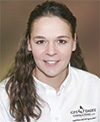In layman’s terms, what does TTNDFd mean? Total tract neutral detergent fiber digestibility (TTNDFd) is a measure of the extent and speed of fiber digestion throughout the entire tract of a high-producing dairy cow, taking into account the overall rate of passage of fiber through the digestive tract.
Neutral detergent fiber (NDF) is comprised of the most-difficult-to-digest portions of the plant: cellulose, lignin and hemicellulose. In the lab, a neutral detergent solution is used in the process of removing other carbohydrate products from the plant – hence the name.
Total tract refers to the entire digestive tract of the cow – the reticulorumen as well as the intestinal tract. This is important because although the majority of fiber is digested in the rumen, about 10 percent can be digested and absorbed in the hindgut.

How is it measured?
TTNDFd combines three values into one measurement:
1. Kd rate (rate of digestion) =how fast the fiber digests
2. Kp rate (speed of passage) = how long the cow holds the fiber in her system
3. NDFd (extent of digestion) at 24, 30, 48 and 120 hours = how much of the fiber is digestible
TTNDFd values are derived by near-infrared (NIR) analysis and are expressed as a percent of NDF. The percent TTNDFd of the samples within the NIR database have been determined by wet chemistry methods of fiber digestion in a simulated rumen environment. Turnaround time for NIR TTNDFd is one day, and the cost of the analysis is $26.

What impact does it haveon a ration?
Knowing the TTNDFd value of a forage can impact the ration by allowing a nutritionist to better explain why a given forage may be feeding differently than another with the same relative forage quality or MILK2006 value.
Currently, a nutritionist cannot use the percent TTNDFd directly in ration formulation software; rather, it can be a tool to better understand the impact of the ingredient on digestion rates and dry matter intake (DMI). Low percent TTNDFd can lead to slow rate of passage and a lower DMI.
The average TTNDFd for forage is 42 percent; David Combs (University of Wisconsin – Madison) suggests a goal of 48 percent and states that a 2- to 3-unit change in TTNDFd corresponds with 1 pound of milk production change. Forage hybrid, growing conditions and cutting management all affect the percent TTNDFd.
To borrow an analogy from Dr. Combs, knowing the percent TTNDFd of a forage is like knowing the “miles to empty” on my GMC Yukon. It’s not enough to know how many miles per gallon the truck gets or to know how many gallons I have left in the tank.
To estimate when I’ll have to pull over and refuel, I need to know both. The rate of digestion of a forage (expressed as kd rate) is similar to my gas mileage, and the amount of potentially digestible NDF at 24, 30, 48 and 120/240 hours lets me know how many gallons are in the tank.
For example, if I told you that my truck gets 16 miles per gallon, could you tell me when I should stop for gas without knowing how many gallons are in the tank? No. Likewise, if I told you the kd rate of your corn silage is 5.6 percent per hour, I could not tell you how much digestible NDF the cow will consume unless I know the total amount of potentially digestible NDF available to her.

What percentage of your clients do you think really understand this value?
Today I am using TTNDFd as a tool to evaluate potential digestion differences between corn silage hybrids and to help explain how the growing season has affected the performance potential of a forage. There is potential for TTNDFd to become more widely used in the industry, as a very small percentage of my clients currently utilize or understand TTNDFd.
Rock River Labs is at present the only feed testing laboratory offering the analysis. Looking into the future, the University of Wisconsin is investigating the potential of including TTNDFd into other decision-making indices. PD

-
Sarah Daugherty
- Nutritionist
- GPS Dairy Consulting, LLC







